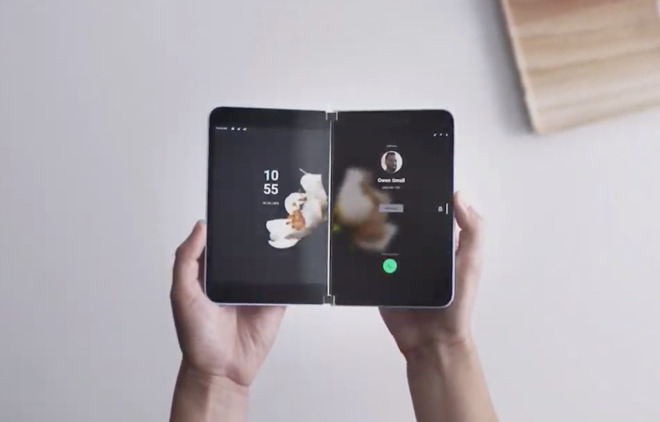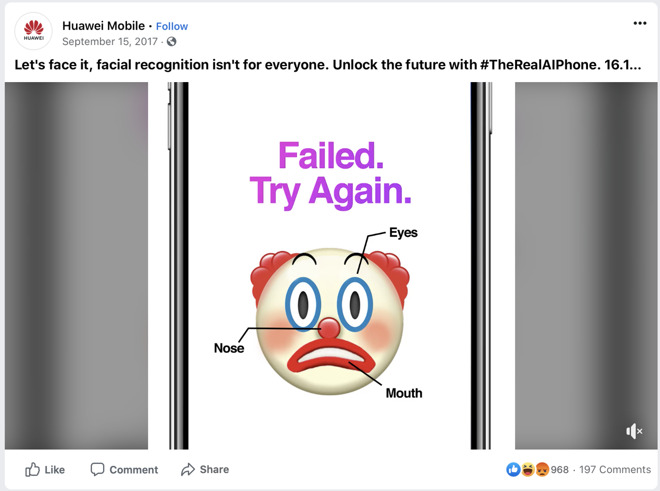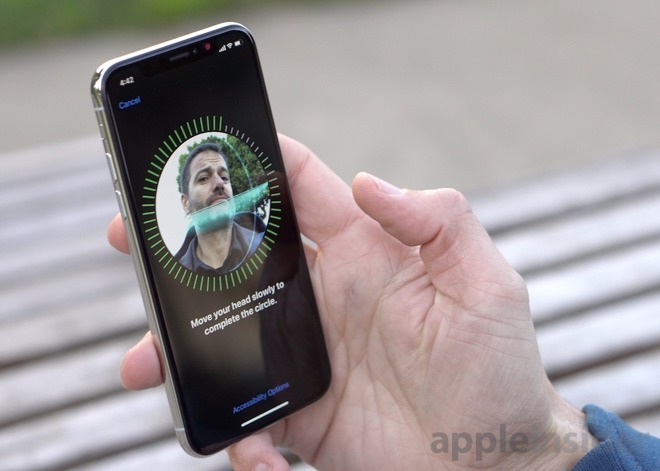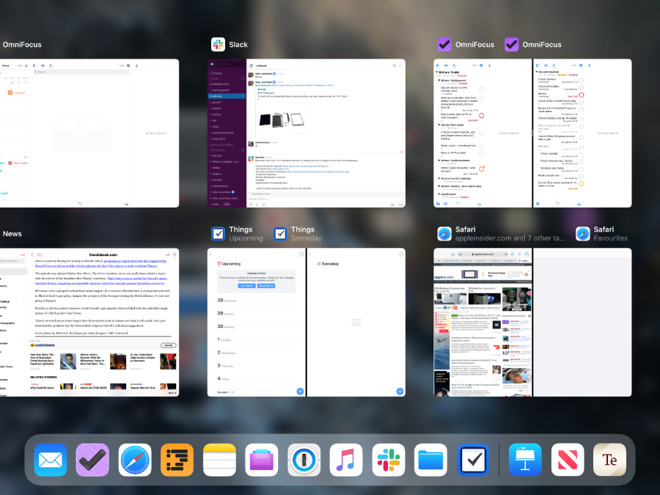
Microsoft portrayed Surface Duo as functional months ago. It still isn't, and nobody cares
The point of a demo is to garner interest in a subject
"Microsoft's Surface Duo demo (Android) just failed. Clearly this isn't ready yet," tweeted Tom Warren, a senior editor at the Verge watching the event On Tuesday. His tweet included video of the new device attempting to show off Microsoft's progress in modifying Android to work across two display panels, including the ability to simply expand an app (Google Maps) to work across both screens.
It refused to work despite multiple attempts.
Microsoft first debuted plans for its Android-based Surface Duo—a dual screen Android tablet with a folding hinge slated to arrive later in 2020 —last October alongside a larger but similar dual screen tablet running Windows 10 called Surface Neo. Both were intended to support independent apps running on each panel, or expanding to fill both displays.
So it's kind of a big deal that the core feature defining the value of the Surface Duo is still not even functional in Microsoft's version of Android, despite the company's expectation that Android developers should be trying to tweak their apps to work across Microsoft's still dysfunctional implementation of dual display panels, just in case there is any interest in the product later this year when it is supposed to arrive. It also still has no price tag.
The fact that it's not working is an issue, but a larger problem is that nobody's caring. The high-stakes nature of a live demo makes any failure or even an unexpected departure from the script an embarrassment. However the complete collapse of Microsoft's efforts to show off the core functionality of the Surface Duo—to developers, more than four months after it was first shown off as an ostensibly functional concept, and around eight months before it is supposed to ship—should at least be considered newsworthy.
Compare the industry's reaction to the debut of Face ID
When Apple's head of software Craig Federighi first demonstrated Face ID on the newly unveiled iPhone X in September 2017, things similarly didn't go as expected. But rather than simply moving on to focus on Apple's future plans for its radical new gesture-based UI that aimed to erase the Home Button that had defined iPhone since 2007 and its Touch ID that had become standard since 2013, media personalities latched onto the demo failure of Face ID with glee and gusto.
Craig Federighi suffered through a moment of terror at the introduction of Face ID
The Verge itself considered Apple's Face ID demo failure worthy of an article, rather than just the brief tweet that Warren used to mention Microsoft's demo crash this week.
Beyond tech blogs, the Telegraph UK published the story "Apple suffers embarrassing demo Face ID fail at iPhone X launch," which claimed that Federighi "struggled to unlock the device." It included reactions from minor Twitter accounts mocking the incident in its "technology" section.
Huawei launched a Facebook campaign just days afterward than portrayed a clown face failing to unlock a device, with the caption "let's face it, facial recognition isn't for everyone," and pointing to a future launch of its own phone with a copycat biometric feature it referred to as "#TheRealAIPhone."
Google and Android licensee Samsung had already rushed out their own facial biometrics, but these were not secure and easily duped. Few were talking about their failures.

Huawei ridiculed the company that designs its phones
Alongside all the Internet speculation and mockery, it quickly became clear that Apple's demo of Face ID hadn't actually suffered a technical failure at all. Instead, the feature had worked as intended.
Because the demo unit had been exposed to multiple faces of the people working off stage, Federighi's initial attempt to unlock with his own face didn't provide access to the phone—he had already been locked out by Face ID's strict privacy policy. A backup iPhone X ready for unlock did work.
Apple's new $999-and-up "future of the smartphone" with Face ID subsequently went on sale just weeks later, and iPhone X immediately became the best selling phone of the holiday season, with researchers specifically crediting Face ID and its TrueDepth camera as "major drivers" of its sales and in user satisfaction with the new product.
Apple has since sustained its success with Face ID across the last three years despite incessant criticisms that insisted that customers would dislike Face ID and really wanted a Touch ID backup included in future models, perhaps on the back or under the display.
Months after iPhone X's debut, Tripp Mickle of the Wall Street Journal published the unsupported claim that Apple had struggled to hedge its bets in including both Face ID and a Touch ID backup, but that "troubles incorporating the new technology led to delays in the manufacturing process, and forced Apple to abandon the use of fingerprints as an option to unlock the phones."

There was never a fumbling last minute attempt to get Touch ID on iPhone X
That was false. In fact, three months before Mickle wrote his story, Apple's senior vice president of hardware engineering Dan Riccio had explained on the record in an interview with TechCrunch that rumors that Apple "couldn't get Touch ID to work through the glass so we had to remove that," were completely unfounded.
Instead, Riccio stated, "we spent no time looking at fingerprints on the back or through the glass or on the side, because if we did those things--which would be a last-minute change--they would be a distraction relative to enabling the more important thing that we were trying to achieve--which was Face ID done in a high-quality way."
It's pretty bold to publish false, unsupported rumors months after an authoritative source has publicly stated that the rumor was false, but the Wall Street Journal gives Mickle wide berth in manipulating the truth when he writes about Apple because stories about Apple are in high demand, regardless of whether they are remotely true, verifiable or even plausible. Even Bloomberg suffered very little for its ballsy publishing of a false, unsubstantiated report claiming that Chinese operatives had installed "spy chips" on servers that had been installed within Apple's secure networks.
Talking about Apple is so lucrative, it doesn't matter if it's accurate. The corollary to that is that the accuracy of talkers doesn't matter much even to Apple because the publicity is so valuable. Apple's executive team has only issued rebukes of false reports on a handful of occasions.
Apple's chief executive Tim Cook specifically called out the Bloomberg "Big Hack" and described Mickle's Wall Street Journal reporting on Apple as "absurd," briefly noting that his work "shows a lack of understanding about how the design team works and how Apple works" and that Mickle's piece "distorts relationships, decisions and events to the point that we just don't recognize the company it claims to describe."
It was the best of demo flops, it was the worst of demo flops
Rather than devoting time to set the record straight with every blogger who has a steaming hot take on why Apple is doomed, the company almost appears to invite loose lips to ineffectually try to sink its ships. Unlike other company events I've attended, rather than simply telling journalists the talking points of what they should write about, Apple seems to step back and ask media observers what they think of their new products on display.
The excessive scrutiny of Apple's Face ID demo embarrassment was certainly linked to the outsized attention Apple focused on the debut of iPhone X. Apple boldy claimed it was seeking to deliver "the future of smartphones," and Face ID and its TrueDepth camera system were key parts of its Phone X overhaul that ultimately shifted how hundreds of millions of people would use their primary personal computing device.
Apple was clearly both proud and confident in its new Face ID. But it also obviously wanted people talking about it, and it didn't matter if they were talking it up or talking it down. There was never any expressed concern among Apple representitives that Face ID was going to fail because of negative media blowback. But it might fail if nobody thought it was worth talking about at all.
In the end, despite lots of often-negative chatter about Face ID, the majority of Apple's phone sales shifted the new Face ID-equipped iPhone X. It then rolled out Face ID to its mass-model iPhone XR the next year, moving exclusively to an entire new-model lineup of Face ID iPhones. That's "courage" when most of the blogosphere is announcing that Touch ID would inevitably need to make a supporting comeback and predicting that Apple would soon ship a fingerprint scanner working under the display glass.
In parallel, Android struggled to clone Apple's new smartphone model, with Google's own copycat swipe navigation gestures failing to catch on across the platform. Google itself copied the surface appearance of Apple's notch on its Pixel phone without even delivering its functionality. And the comforting message among many Android bloggers was that users didn't have to worry about face biometrics failing on Android because most phones had a fingerprint backup. It's like the opposite of a call to action: your existing Android is okay.
The negative chatter targeting Apple and everything it does has not only proven to be wildly ineffectual at turning audiences away from Apple, but has also served to burn up all the oxygen in Android-land. Most Android blogs spend much of their time talking about iOS. That once included lots of derision of Face ID. Android bloggers also employed some backwards reverse psychology to denigrate Apple's Face ID phones: one thing you really don't want to think about are those terrible Animoji's and silly talking poos.

Newspapers scrambled to write up how absurd it was to animate poop, handing Apple even more free publicity
Pundits continued to harp on Face ID and the supposed problems Apple might suffer even as the company rapidly transitioned to an entirely new navigation model for its core business—an unprecedented shift in the history of technology. In the early 2000s, Apple struggled for half a decade to shift its classic Mac users—and app developers—to the only slightly new UI conventions of Mac OS X. It was a fight.
Microsoft ran into an even tougher wall when trying to similarly shoehorn its Windows XP users onto its own Vista "vision of the future of the PC" in 2006. It has continued to ineffectually struggle in its attempts to transition its Windows PC users into tablet or convertible-slate users, or even to sell its base Windows Phones. Windows 8, Windows RT, Windows Mobile 10, and the Metro interface that attempted to push legacy Windows users into Microsoft's concept of the future have all been miserable slogs that forced the company to diversify away from its core Windows business and focus on new opportunities such as cloud computing.
Yet in all of these cases, Microsoft bloggers desperately tried to put a happy face on things, insisting that Windows Phone was actually really good and that third party apps weren't really necessary. The serious issue of Windows RT not actually being able to run most existing Windows apps was blown off as something nobody needed to talk about, until the reality hit the fan and buyers simply soured on the idea of buying a Windows RT tablet that couldn't run Windows software any better than an iPad could.
The only thing worse than being talked about is not being talked about
Evan Spence, Mark Gurman, Don Reisinger, Mickle, The Verge, and other bloggers who weekly complain that "bad news is piling up for Apple" have never seemed to contemplate how little actual impact their constant tales of doom have had on Apple. The traveling media circus that follows Apple around calls to mind the Phineas Barnum quote that "there's no such thing as bad publicity."
Consider how little the years of a media-led circus of keyboard histrionics have had on sales of MacBooks, which keep hitting new revenue records even as PCs have stubbornly refused to grow. Bloggers seem to take inordinate pleasure in claiming credit for sensationalizing rather routine technical issues as being scandals on par with Nixon's Watergate impeachment, a sort of end-run around Godwin's Law.

Oscar winner Taika Waititi talked about Hollywood using MacBooks--for free
Most recently, a backstage Oscars mention of MacBook keyboards by award winning screenplay writer and director Taika Waititi revealed that Hollywood's top talent preferred Apple's notebooks—but were still complaining about them. His remarks were hailed as a big problem for Apple, but it was actually free advertising. Samsung had to pay top dollar to get a mention of its product inserted into the Oscars, and even that paid message was tacked to the acknowledgment that its new folding phone featured a big crease across its display.
If Apple had paid to advertise its MacBooks there would still be the same discussion going on regarding keyboard complaints. Yet if Waititi had instead talked about owning a new Galaxy phone while complaining about its screen defects, it would have been a big win for Samsung, which is desperately trying to gain some attention for its latest efforts beyond volume sales of cheap commodity Androids.
Samsung is no stranger to bad publicity. Over the last decade it has endured years of extended talk related to its copying of iPhone and iPad during the patent lawsuits. It was dragged across coals for its battery fires, and was then gently ripped over its broken Galaxy Fold prototypes. However, unlike the criticisms targeting the products and features Apple was actually selling, Samsung's peak periods of notoriety didn't align with having a product available to sell. Imagine getting free publicity and then squandering it because your products are so bad you can't even continue to sell them.
In contrast, all of the denigration of Face ID that critics attempted to foist on Apple starting in 2017 largely amounted to free advertising for what would have otherwise been a difficult to sell feature. Without anyone talking about the new technology, how could Apple have possibly lined up tens of millions of people globally and sold them a $999 phone, a feat that nobody had ever accomplished before—not even the ultimate technology salesman Steve Jobs himself.
Talk is cheap
If newspapers weren't full of editors who absolutely hated Apple and couldn't stop talking about how terrible the company was and how doomed it was for making decisions that were clearly disastrous, it would have to spend far more of its profit stream on advertising. Samsung was at one point spending $14 billion on marketing efforts to launch its smartphone business, an unsustainable effort that collapsed as soon as its board determined that it couldn't keep burning so much money to drum up attention.
Microsoft similarly spent ineffectual billions to launch Vista, Surface RT, Windows Phone, Windows 8, and other initiatives that it just couldn't get anyone to talk about otherwise. Outside of the people who get paid to type up optimistic reviews of Microsoft's consumer efforts, there simply isn't much genuine interest. This is obvious in any mall where Microsoft has installed a retail store. They're invariably empty, despite hosting a free Xbox console and having the exact same styling as an Apple Store.

Dance like nobody's watching
Microsoft has found that it's as hard to pay people to talk about its products as it is to pay people to build apps for Windows Phone. The whole point of developing a third party ecosystem is that you harness the efforts of other people to work for you, for next to nothing. It's impossible to afford to pay enough people to do that for you out of pocket.
Apple's software, accessories, podcast, services, and subscription ecosystems are just now getting recognized as adding massive value to what it already a vast global business. But the media circus that follows Apple around desperately trying to outdo each other in their biting criticisms is doing little more than attracting and retaining an audience that thinks about Apple far more often that it would if there were no circle incessantly jerking on Apple's chain.
What if Microsoft throws a demo and nobody cares?
When Microsoft attempts to show off a key strategic product that spectacularly melts down into demo embarrassment and nobody cares, that also indicates that nobody really cared that much about Microsoft's vision for the future.
Surface Duo is not some inconsequential side product at Microsoft. The company's entire new tablet strategy for 2020 is fully grounded on the concept of multitasking across two separate panels joined by a hinge. That's in contrast to Samsung and various Chinese Android licensees who have worked to deliver a single, folding display, or Apple's current mobile approach focused on a single display with no moving parts to break.
Apple has adopted Samsung's best flexible OLED panels, but used them to deliver iPhone X's seamless corners and edge-to-edge display rather than trying to deliver a screen that actually flexes in normal use. The company's patents do indicate that Apple has experimented with folding displays, and Apple does have a product that folds with an innovative hinge and sports two separate displays: its MacBook Pro with Touch Bar. But Apple hasn't staked its reputation on delivering either a dual screen desktop or a flexing, folding display. If it does, you can be sure that any failed demo of it not actually working would be newsworthy, globally.

Apple's iPadOS multitasking model has been brutally critiqued by fans. Imagine if it didn't work at all in 2020.
The dual-screen device Microsoft intended to demonstrate this week effectively represents the core value the company is hoping to add to Android. Microsoft's Duo drag-and-drop UI seeks to "embrace and extend" Android, differentiating its upcoming Surface Duo from commodity Android tablets—including Google's own, now-abandoned work on the Pixel C.
Embracing Android is an unusual step for Microsoft, which has long made using its own Windows OS central to its product strategy. Microsoft's dozen years of trying under Bill Gates and then Steve Ballmer to sell Windows Tablet and Windows Mobile finally climaxed in a partnership with Nokia that intended to leverage the Finnish phone giant as a fortress supporting Windows Phone and Windows Tablet against the further expansion of Android.
That anti-Android strategy culminated in the 2013 acquisition of Nokia in an ineffectual $7.6 billion money shot that ultimately did nothing to keep Windows relevant on mobile devices. Microsoft then doubled down on Windows with an RT version aimed to run on lower power chips. When that failed, Microsoft scaled its vision for the future of tablets upward, encouraging its base to claim that iPad was merely a "consumption device" and that Windows PC "detachables" and other notebook PCs with tablet features tacked on the side were "real computers," another strategy that was ultimately unsuccessful.
Once again, notice how ineffectual it has been for Microsoft to sponsor the punditry that generates market share figures and predicts future wins for its platforms. Apple hasn't wasted its money on IDC, Gartner, and Strategy Analysts to shape public opinion. It has a fan and foe base doing that for free, with far better results to show for its lack of spending.
Across nearly a decade of trying to build its own tablet and hybrid notebook hardware under the Surface brand, Microsoft has struggled with getting Windows and Windows apps to run well on mobile processors. Windows has historically demanded more RAM and faster x86 processors because of its much greater overhead compared to Apple's streamlined design for iPad.
As the rest of the Android mobile device industry latches onto folding OLED panels in an attempt to compete with Apple for attention, Microsoft's unique efforts to bet the farm on a hinged pair of separate displays is at least novel. The fact that it has to use Android to deliver a version that can be priced below the typical pricing of Surface devices is also notable.
But the fact that Microsoft was unable to even show off a working version of its plans to modify Android to support drag and drop between the dual display panels of its Surface Demo—aimed at the very developers it hopes will invest in its fork of Android conventions—says a lot about how poorly positioned Microsoft is in the battle for the future of mobile devices.
Microsoft now has two different OSs and app platforms to manage, no real hope of significant retail sales, and the company completely lacks the proficient hardware operational structure Apple has leveraged to drive mobile prices down across vast volumes of sales to audiences globally. Yet despite being first and foremost a software company, Microsoft can't even show off the functional bit of rather routine UI functionality as it planned, months after hyping up a product it didn't plan to sell for another year.
But even worse, nobody is interested enough in Microsoft's future products to think that its Surface Duo demo disaster is worth talking about.
"Demo" - Google News
February 12, 2020 at 11:43PM
https://ift.tt/2USsyiS
Microsoft's Surface Duo suffers a Face ID-style demo failure, nobody cares - AppleInsider
"Demo" - Google News
https://ift.tt/35q1UQ2
Shoes Man Tutorial
Pos News Update
Meme Update
Korean Entertainment News
Japan News Update

No comments:
Post a Comment